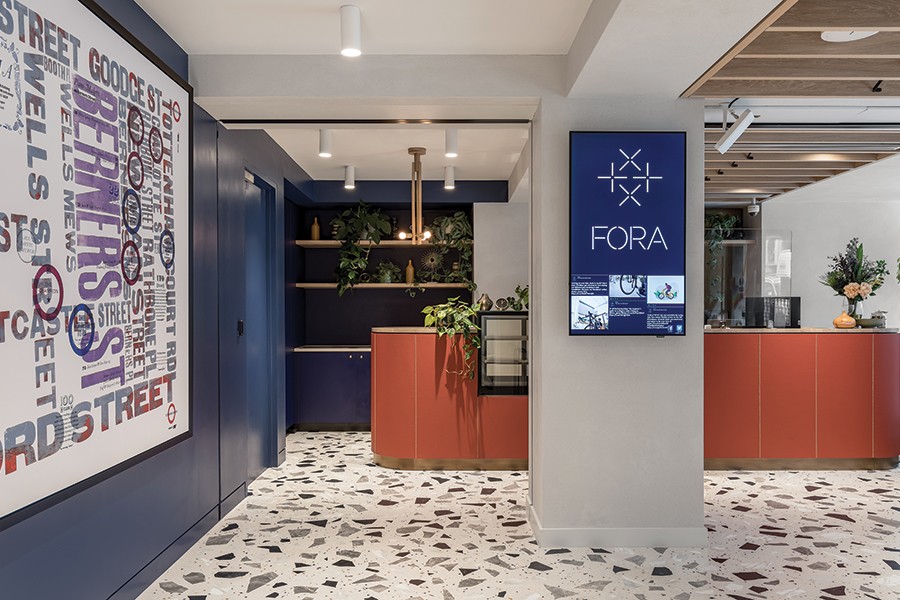Formed in the late 19th century, Diespeker & Co is a company with many strings to its bow: from stone to quartz and terrazzo, from manufacturing to stocking and even installation, the business has consistently expanded its offering over the past century and a half. Recently, TSJ spoke with managing director John Krause about how the company has kept itself in demand throughout its long lifespan, as well as some of his plans for the future.
Diespeker & Co began life in 1881 when Sigmund Diespeker and his associate, craftsman Giovanni Mariutto, travelled to the UK on behalf of an Italian entrepreneur to research the local terrazzo and mosaic market. Seeing the opportunities present in that market, however, the pair decided to forego returning to Italy and instead established what’s said to be one of the first companies to supply terrazzo and mosaic in the UK. “Our roots are in terrazzo,” Krause explains. “And that was the case for most of our early history.”
In fact, terrazzo and mosaic remained the company’s bread and butter for almost a century, until fashions turned in the 1970s and terrazzo “died a little bit of a death”. As the material became less and less popular during this period, Diespeker (along with the many other companies supplying terrazzo at the time) began to pivot towards the stone industry, focusing more on marbles, granites and limestones. That heavy focus on stone lasted all the way until around seven years ago, Krause explains, when terrazzo experienced a “revival of interest,” thanks to the attention of high-profile designers such as Max Lamb and even Valentino. “We picked up on it quickly, I think, and put lots of effort and time into focusing on that area.” At this point, he says, terrazzo once again makes up the main proportion of Diespeker’s business.
With this abridged history of the company established, we arrive at today, with Diespeker occupying a rather enviable position in the UK market. In addition to its expertise in various types of stone, the company covers every single angle of terrazzo, Krause says. “Whether it’s precast, whether it’s resin or cement-based, we’re installers and manufacturers of terrazzo. We also make bespoke terrazzo here at SE15, just two miles from Tower Bridge. We import chippings and slabs from throughout the world.”
Interestingly, the company stocks a significant amount of premade terrazzo slabs, making it one of the largest terrazzo stockists in the UK by Krause’s estimation. While there are other suppliers, slabs are typically made-to-order, while Diespeker stocks around 3000 across two facilities. The reason this is so rare, Krause says, is that storing terrazzo is something of a specialist challenge. He likens the slabs to “a delicate marble,” with their own trickiness and issues.
It is perhaps because of these issues that, despite the increased popularity of terrazzo over the past half a decade, relatively few of the companies that exited the market during the 70s have made a serious return to the material. “And that’s good for us,” Krause says. “Without sounding too boastful, I do feel as though we dominate this sector.”
Much as it is fashionable again today, however, Krause is aware that terrazzo could easily fall out of favour just as quickly as it did in the 70s. “Obviously, it’s a trend really, and I’m more than aware that this will very likely pass. But there will always be a market for it, there’s always going to be a business there. It’ll be a scaled down version of it, if you like, but for the minute it remains very, very much in.”
If and when terrazzo does lose its lustre for the design community, however, the company’s ability to pivot back to focusing on natural and engineered stone means it remains in a position to capitalise on the next trend – whatever it may be.
A team effort
For a company operating at the level of Diespeker, its staff of 45 initially looks rather compact, although there are some “bolt-on” entities, Krause explains: a cost consulting firm, a marketing company, and a personal company consultant. Between those core employees, around 10 work in the office, 20 work in the factory, which leaves around 15 on site. While this team is somewhat lean, it doesn’t seem to curb Diespeker’s versatility in any meaningful way, both in terms of the products the company supplies and the jobs it takes on. “We cover a massive cross section, which I think makes us quite unique.”
In just the last few years, for example, the company has undertaken two commercial installation jobs in London that were “almost a million in order values,” Krause says. At the same time, the company is supplying flooring, vanity tops, kitchen counters and more to domestic and small commercial clients. “Lots of countertops recently, which are mainly terrazzo, but obviously also marble and engineered stone and granite.”
In fact, it’s in these more bespoke jobs that Krause believes Diespeker distinguishes itself. “We take on the tricky ones, the ones that very few people can do. Certainly, custom-made stuff, but also because we’ve got slabs, we can move very quickly, so that’s an area we make gains.” Between the ability to manufacture onsite, store and install these materials in a variety of contexts, there seems to be very little that stumps the company.
Krause attributes this flexibility and competence primarily to the “phenomenally good people” at Diespeker. “We’ve got a £220,000 machine being delivered in two weeks, but in truth I would sacrifice that any day of the week for the people, because without them we’re nothing. We’ve got the best group of people I’ve ever had in my life surrounding me.”
Material concerns
The challenges Diespeker does face are largely external, Krause says, like making sure clients are correctly informed about the product they’re buying. For example, with terrazzo: “We have to be quite careful with managing expectations. Sometimes we need to explain – this isn’t bomb-proof. If you want something bomb-proof, or at least close to, then you should really be considering granite or engineered stone. Terrazzo is more like a fragile marble in essence. And while sealers reduce the risk of staining and marking, they’re not foolproof. We try and make it very, very clear, because there is nothing more upsetting than clients that come back to us because they don’t appreciate or understand what they’re buying.”
Fortunately, the installation is broadly the same between the different slabs, Krause explains, so the company’s fixing team can consistently create high-quality finishes regardless of the material chosen. But while the staff at Diespeker are experts in the materials it supplies and the differences between them, these subtleties can sometimes be lost on specifiers. “You do need to be mindful that you might be buying something that’s aesthetically amazing, but it’s like a silk dress: it can tear, and you have to be careful washing it in a way to not damage it.”
Of course, Krause is aware that the level of talent and expertise in the installation team is a product of experience, and he is concerned about the growing skills shortage. While the business currently doesn’t have any structural initiatives in place to address this challenge, the managing director says it has tried to institute a culture of improvement. “We’ve held onto good people, and we’re always – as a small business – trying to encourage everyone who works here to better themselves and get the best out of people.”
Unfortunately, the issue of skills is much wider than one company, meaning Diespeker’s ability to address it directly is inevitably going to be limited. At this point however, the business has no problems in either securing work or completing it, Krause says. “I think the problem is our industry isn’t that well organised in that area. But it’s not been a big issue to us in truth, partially because we do have people that have been here 20, 30, 40 years, and they don’t seem to be going anywhere, so it’s less of a concern.”
The significant challenge for any company in construction to contend with is sustainability – although here Diespeker does have a more formal plan of action. In fact, it has an entire product dedicated to reusing London’s waste rubble. Rubblazzo is a collaboration between the company and garden designer Tom Massey, and between its recycling of London’s architectural waste and the relatively small carbon footprint of its production (all manufacturing and transport happens within London) the product forms a suitably eco-friendly addition to Diespeker’s portfolio. In fact, Krause even chose it for his own garden! “Personally I’ve very much taken that on board – I could have had absolutely anything in my garden, but I chose that.”
Continuing the legacy
For Krause himself, the last ten years have represented “the crest of the wave” of his more than 40 years with Diespeker. Joining the company at 17 and working part-time through school and university, he rose through the ranks from estimating and project management to co-managing director with his brother, before becoming the company’s sole MD around twelve years ago. During that time, the business’ turnover has risen from around one and a half million to four or five million pounds a year, Krause says. “If you look at us financially, we’ve never been stronger in all of my years with the company, so that makes me super proud.”
Of course, he acknowledges this state of affairs is a rather unusual one for a company of Diespeker’s size. “I won’t hide it at all that I’m looking for co-directors within this group. I recognize that at 63, I’m at the tail end of my working life and I want my legacy to make sure this business will continue to trade when I’m not here.” To this end, Krause has selected a group of around seven people at the company who are now being fast-tracked specifically for management, with the aim of making the MD “obsolete” within the next few years.
Certainly, this would give Krause a little more time to pursue his main hobby of running marathons. Over the past 23 years, he has run over 200 marathons, along with five Iron Mans (an endurance gauntlet requiring 3.8km of swimming, 180km of cycling, followed by a full marathon to finish!)
Balancing this intense exercise regime with his position at Diespeker – not to mention his family life – sounds like a near-impossible task, but Krause falls back on some old wisdom to explain: “They do say if you want a job done, give it to a busy person!” Indeed, not content with the commercial side alone, Krause has also leveraged Diespeker’s business success to support a charity, stem4.
The charity aims to improve teenage mental health “by stemming commonly occurring mental health issues at an early stage”. As the company’s chosen charity, Diespeker has raised funds for stem4 through several events (many of which being Krause’s own marathons!) This ability to do good in the world through his business has been a major motivating factor for Krause, who describes Diespeker’s support of the charity as one of his proudest accomplishments. “We’ve associated for 12 years now, and we’ve pushed and promoted it in our own way.”
Unsurprisingly then, although he recognises the imperative to plan for his inevitable departure from the company, the MD is reluctant to start planning a leaving party any time soon. “My intention is not to go anywhere. If I can hold on and go further still, I’ll be here for the long stay.”
www.diespeker.co.uk








